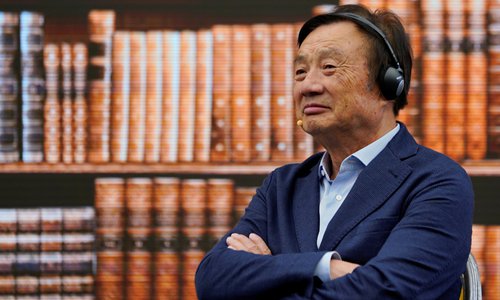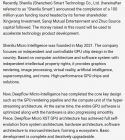Unfortunately, this news has refutable statements: 1. Huawei hasn't claimed; it's a thread started by a community user. 2. HuaweiCentral doesn't belong to Huawei. Nevertheless, an alternative to ASML's EUV is necessary for everyone that doesn't believe in zero-sum geopolitics.
You are using an out of date browser. It may not display this or other websites correctly.
You should upgrade or use an alternative browser.
You should upgrade or use an alternative browser.
Chinese semiconductor industry
- Thread starter Hendrik_2000
- Start date
- Status
- Not open for further replies.
Bro what we gather from this forum and our distinguished members is that the power source is the only component that is inadequate, they already mastered 2 of the 3 Core tech needed for an EUVL. Late in 2019 a famous Chinese poster by the name of A-SET already gave us the preview, early on they are working on DPP and the max they able to produce is at 125W to 150W clearly not enough to be use commercially. We learned from @WTAN that they are working on LPP together with SSMB, so Huawei RS laser may have taken the task regarding the LPP while other state scientific institution contribute on others. This whole nation approach are bearing fruits, as the Chinese are preparing for a major American onslaught or escalation next year.Interesting, it seems Huawei and their partners with would need to possess a small scale technology demonstrator to be able to overcome the issue described in the patent. It's not something you would want to rely solely on computational simulation (if that's even possible) and if you were going to patent this process, you would expect the proof of concept to have been verified through some means otherwise the patent is vaporware. Although we can't infer any capabilities or specs like throughput, this is excellent for multiple reasons:
1) Even if this is a small scale prototype/demonstrator, it means they have actively solved or are working on solving many of the workflow sequences for EUV lithography.
2) To be able to solve the experimental problem described in the patent, the prototype/demonstrator must reasonably approximate the conditions encountered during operating scenarios. Therefore, it can be reasonably inferred that the prototype/demonstrator integrates concepts that would be mirrored in a full scale system in terms of key operating principles, sub-systems.
3) The sub-systems and integration into the prototype/demonstrator must be meeting the right levels of precision, accuracy, etc. They may not be there in terms of throughput or other commercial volume specs, but they are sufficient to establish a working proof of concept. There are other components/systems that will need to evaluated for a commercial setup that aren't required in a prototype/demonstrator.
4) The fact that they worked around ASML's patent shows that China is playing its cards smartly. If they wanted, they could just void ASML patents and go with the same implementation but seeing as to how ASML brings alot of value, there is no gain in alienating them when they still bring alot of value as healthy competition (circumstances permitting).
Exciting times, look forward to seeing what else comes forward.
Global times circa Sept 2020
Huawei teams up with CAS on technological development
By
Published: Sep 20, 2020 09:03 PM

Ren Zhengfei
Huawei is inviting professionals across China, from top research institutions to universities and companies, to join efforts in technological research as the Shenzhen-based technology giant tries to blaze a trail out of the US blockade.
Recently, Huawei executives including founder Ren Zhengfei, visited the Chinese Academy of Sciences (CAS) to discuss fundamental research and core technology development with CAS experts and scholars. The visit came just weeks after Ren and his colleagues visited four Chinese top universities to enhance professional training.
During the visit, Ren said that Huawei attaches great importance to its cooperation with the CAS.
"Based on current cooperation between Huawei and the CAS, I hope the two sides can strengthen scientific exchanges with a more open attitude, while exploring the frontiers of science and technology, and pushing the conversion of research results into economic prowess," Ren said.
CAS dean Bai Chunli also noted that the CAS has carried out "multiple-layer", "broad" and "pragmatic" cooperation with Huawei, with this kind of teamwork having produced good results.
"I hope Huawei and the CAS can cooperate closely, combining the innovation abilities of CAS and the resources of Huawei to explore frontier technologies," Bai said.
The visit again showed Huawei's thirst for a solution following the US order limiting global supply of electronic components to the Chinese tech giant, analysts said.
"Huawei's current chip inventory can sustain its market share for about two years. After that, unless Huawei can come up with a good solution to obtain chip supplies, its market share might falter, which will be a threat to the brand's competitiveness and even survival," Sun Yanbiao, head of Shenzhen-based research firm N1mobile, told the Global Times on Sunday.
That means unless policy changes come from the US government, Huawei has to develop its own tech solutions within a rather short period, pushing it to seek cooperation with academic and research powers in China.
"It would be a win-win situation for Huawei and the CAS. The CAS can help Huawei with research equipment and R&D projects, while Huawei could support some CAS projects with capital," veteran industry analyst Ma Jihua told the Global Times.
According to him, there's no guarantee that input will yield results, but considering that China's chip technologies do not lag too far behind, it's hopeful that Huawei and its partners can work out independent tech solutions that can allow China to produce high-end chips by itself.
"Faced with the US crackdown, China needs to complete technological independence in just about one-tenth of the normal time needed for such a process to take place. But it has to try," Ma said.
He added that China is also demonstrating its determination in technological independence to the world, thus prompting US enterprises to exert pressure on the US government as they would experience great losses if China could make everything on its own and no longer needs to import products from the US.
Microsoft founder Bill Gates also questioned in a recent interview whether it is good to "force China to become fully self-sufficient", adding that cutting supplies to China would cause job losses and the US would sustain the most serious damage in the long run.
There already a lot of EUV technologies in China already since very early, including prototype machines. And the development of EUV in China just keep growing, already posted some of that stuff here and the rabbit hole is pretty deep. And yes there is a lot of patented technologies in EUV masks, pellicles and photoresists and there is already signs of commercial activity in China regarding EUV technologies, including EUV mask, maybe someday I will post some findings in the future or not. So is very probably that Huawei receiving a lot of support in this endeavor, I would not surprise if a bigger level of support than SMEE. Given the fact the Huawei can hire more people than SMEE.Interesting, it seems Huawei and their partners with would need to possess a small scale technology demonstrator to be able to overcome the issue described in the patent. It's not something you would want to rely solely on computational simulation (if that's even possible) and if you were going to patent this process, you would expect the proof of concept to have been verified through some means otherwise the patent is vaporware. Although we can't infer any capabilities or specs like throughput, this is excellent for multiple reasons:
1) Even if this is a small scale prototype/demonstrator, it means they have actively solved or are working on solving many of the workflow sequences for EUV lithography.
2) To be able to solve the experimental problem described in the patent, the prototype/demonstrator must reasonably approximate the conditions encountered during operating scenarios. Therefore, it can be reasonably inferred that the prototype/demonstrator integrates concepts that would be mirrored in a full scale system in terms of key operating principles, sub-systems.
3) The sub-systems and integration into the prototype/demonstrator must be meeting the right levels of precision, accuracy, etc. They may not be there in terms of throughput or other commercial volume specs, but they are sufficient to establish a working proof of concept. There are other components/systems that will need to evaluated for a commercial setup that aren't required in a prototype/demonstrator.
4) The fact that they worked around ASML's patent shows that China is playing its cards smartly. If they wanted, they could just void ASML patents and go with the same implementation but seeing as to how ASML brings alot of value, there is no gain in alienating them when they still bring alot of value as healthy competition (circumstances permitting).
Exciting times, look forward to seeing what else comes forward.
Huawei is not TSMC or SMIC, so for now it seems they just need some kind of EUV machine that can be used to make the most critical layers of their most advanced chips, so I don't think they are looking for something as performant as the ones that a big pure and play foundry needs. The patent make it to seem that they are looking something that can pattern an specific critical layer. Looks like everything else is going to be done with SMEE immersion and dry machines.
And the yes they are probably cutting through some of ASML patents, given the size of the portfolio that ASML has in China
They put a video in their own website and then remove it.Unfortunately, this news has refutable statements: 1. Huawei hasn't claimed; it's a thread started by a community user. 2. HuaweiCentral doesn't belong to Huawei. Nevertheless, an alternative to ASML's EUV is necessary for everyone that doesn't believe in zero-sum geopolitics.
There already a lot of EUV technologies in China already since very early, including prototype machines. And the development of EUV in China just keep growing, already posted some of that stuff here and the rabbit hole is pretty deep. And yes there is a lot of patented technologies in EUV masks, pellicles and photoresists and there is already signs of commercial activity in China regarding EUV technologies, including EUV mask, maybe someday I will post some findings in the future or not. So is very probably that Huawei receiving a lot of support in this endeavor, I would not surprise if a bigger level of support than SMEE. Given the fact the Huawei can hire more people than SMEE.
Huawei is not TSMC or SMIC, so for now it seems they just need some kind of EUV machine that can be used to make the most critical layers of their most advanced chips, so I don't think they are looking for something as performant as the ones that a big pure and play foundry needs. The patent make it to seem that they are looking something that can pattern an specific critical layer. Looks like everything else is going to be done with SMEE immersion and dry machines.
And the yes they are probably cutting through some of ASML patents, given the size of the portfolio that ASML has in China
They put a video in their own website and then remove it.

at present, ASML has 3000-4000 patents registered in China... they are looking for ways to stop China from developing China's lithography machine... it's an old habit...
10 months ago, ASML planned to sue Dongfang Jingyuan...but i guess they canceled it
Last edited:
I really want to see ASML try SMEE or anyone else in a Chinese courtroom almost as badly as I want to see India try the PLA on the border.View attachment 103941
at present, ASML has 3000 patents registered in China... they are looking for ways to stop China from developing China's lithography machine... it's an old habit...
10 months ago ASML planned to sue Dongfang Jingyuan...but i guess they canceled it
I going to be difficult for them to defend themselves because they don't sell EUV in China and China could treat EUV as critical for "national security" because two can play that game, but one attractive option for ASML is to license their portfolio to at least extract some revenue on EUV in China.I really want to see ASML try SMEE or anyone else in a Chinese courtroom almost as badly as I want to see India try the PLA on the border.
A very hypothetical dream like scenario is that is all the parts are available in China and non US companies, ASML could built China only lithography machines. exclusive for the Chinese market.
Bro you think it might happen? I do and maybe they are waiting for SMEE or Huawei to introduce their EUVL for ASML to open a Chinese subsidiary.I going to be difficult for them to defend themselves because they don't sell EUV in China and China could treat EUV as critical for "national security" because two can play that game, but one attractive option for ASML is to license their portfolio to at least extract some revenue on EUV in China.
A very hypothetical dream like scenario is that is all the parts are available in China and non US companies, ASML could built China only lithography machines. exclusive for the Chinese market.
Bro you think it might happen? I do and maybe they are waiting for SMEE or Huawei to introduce their EUVL for ASML to open a Chinese subsidiary.everybody happy except the US...lol
Yes, now that America has opened the pandora's box of national security when it comes to semiconductor tools, it will be more easy than ever for China to use that itself. If Dutch gov't complains, then China can just use national security gov't since EUV was prohibited from being export due to Wassenaar Arrangement. And if Dutch gov't does go ahead with Arfi scanner ban, it will be even easier for China to just disregard any ASML patent in China with the national security argument.
China is going to push out the most aggressive buy China semiconductor industrial policy imaginable thanks to America setting the precedence of using national security to disregard well established trading practices. ASML and Japanese firms will also suffer big time. Unfortunately, when 2 elephants collide, everyone else gets stamped on.
Manufacturing in China is not new for ASML, they do metrology systems in Beijing and Computaional lithography in Shenzen but making full scanners in China would be a very hypothetical scenario, is fair to say that the Americans will not be very happy at all, ASML will be walking on a minefield and has to be 100% sure that no one that has ever worked in the US with an export control clearance even dream about ASML in China.Bro you think it might happen? I do and maybe they are waiting for SMEE or Huawei to introduce their EUVL for ASML to open a Chinese subsidiary.everybody happy except the US...lol
- Status
- Not open for further replies.

